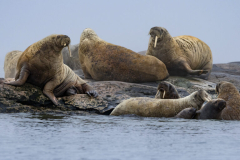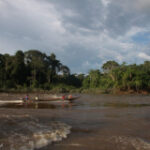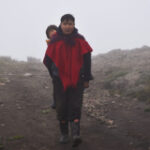- Every species of animal and plant that lives or breeds in the Arctic is experiencing dramatic change. As the polar region warms, species endure extreme weather, shrinking and altered habitat, decreased food availability, and competition from invading southern species.
- A wide array of Arctic organisms that rely on sea ice to feed or breed during some or all of their life cycles are threatened by melt: Over the past 40 years, the Arctic Ocean has lost about 75% of its sea ice volume, as measured at the end of the summer melt season. This translates into a loss of sea ice extent and thickness by half on average.
- Researchers note that the rate of change is accelerating at sea and on land. While species can adapt over time, Arctic ecosystem alterations are too rapid for many animals to adapt, making it difficult to guess which species will prevail, which will perish, and where.
- The only thing that could limit future extinctions, researchers say, is to quickly stop burning fossil fuels, the main driver of climate change.
Walruses have traversed the Arctic for millennia, gregarious pinnipeds that rest en masse on drifting pack ice, diving to feed on crabs, clams and other seafloor delicacies. Icy platforms also serve as safe birthing and nursery grounds. But as the far north rapidly warms and sea ice disappears, some herds now huddle on overcrowded shorelines, with deadly consequences for young calves: Because more disturbances occur on shore than at sea, calves are regularly trampled during panicked stampedes by the 1-ton-plus adults.
Climate-driven changes are affecting other wildlife across this land of snow and ice. On the Arctic tundra, lemmings now struggle to eat, nest and move during the eight winter months they live beneath the snow, as they endure “weather whiplash,” with ever more severe fluctuations in temperature, snow and rain, says ecologist Dorothee Ehrich, at the Climate Ecological Observatory for Arctic Tundra with Norway’s Arctic University.
As warming escalates, animals are on the move, bringing new diseases north. In December, officials reported that H5N1 avian flu infected and killed a polar bear — a global first. This highly infectious strain has circulated internationally since 2021, jumping between species, and has reached the polar region. It’s just one example of new pathogens there, raising serious concern because isolated Arctic species have little immunity to disease.

Researchers are witnessing dramatic shifts in the behavior and abundance of Arctic wildlife on land and sea — shifts coinciding with rapid warming and extreme weather. “The speed of change is really hard to comprehend,” says Kyle Joly, a biologist with the U.S. National Park Service. Both in the Arctic and around the globe, 2023 was by far the hottest year in recorded human history.
With global warming impacts highly magnified at the poles, “ecosystems are rearranging at every trophic level,” says Arctic climate and policy expert Joel Clement. “The Arctic is transforming into a warmer, wetter ecological state before our eyes.” Habitats are eroding as glaciers and sea ice recede, coastlines submerge, and permafrost thaws. Bays that were frozen year-round are dotted with bobbing blue ice floes — or have become open sea.
Radical shifts in weather and temperature reverberate across these ecosystems, making it harder to find food, and increasing pressure from competitors invading from the south. No plant or animal is exempt, from the microscopic plankton and crustaceans that fuel the entire Arctic food web, to the region’s iconic belugas and polar bears, or the 200 or so migratory bird species that breed in the Arctic.
A disturbing question looms: Can these animals evolve quickly enough to adapt to what Clement calls “a new geography of survival”?


Precious sea ice disappearing
A large number of Arctic organisms rely on sea ice during some or all of their life cycles: swimming or sheltering below; attaching beneath pack ice or hunting from atop; nestling in icy cracks; using it as a bed, a nursery, feeding ground, or as a means to travel from one place to another.
Polar ice stretches thousands of miles, touching the shores of eight nations, expanding and retreating in synchrony with yearly cycles of continuous daylight and months-long night. But over the past 40 years the Arctic Ocean has lost about 75% of its sea ice volume, as measured at the end of the summer melt season. This translates into a loss of both sea ice extent and thickness by half on average, offering the most glaring evidence of climate change on Earth.
Shrinking habitat is just one of many issues threatening wildlife. Sea ice is “the life machine of the Arctic … a very productive factory for food,” says Knud Falk, an ecologist supporting the Circumpolar Biodiversity Monitoring Program.
Ice edges are like the coral reefs of the Arctic, a place where animals come to feed and breed. At the end of the annual polar night, as ice naturally melts, algae blooms at its edges, followed by phytoplankton that thrives under the summer sun. This, in turn, draws zooplankton — mostly microscopic crustaceans called copepods — that feed bowhead whales, seabirds and small fish. Next come polar cod, other large fish, seabirds, belugas, and four species of “ice seals.”

In a decades-long study, researchers identified 143 Arctic species that eat phytoplankton. Many time their migrations or breeding to coincide with ice-associated organic blooms. But the location and amount of food is changing as the ice disappears.
The alabaster ivory gull needs sea ice year-round and sometimes even nests on icebergs. In a warming Arctic, its numbers are crashing. About 70% disappeared from Canada’s north since the 1980s. How these seabirds will fare in a sea ice-free Arctic is questionable, notes Falk, an event which could occur as soon as 2030-2050, according to a recent study in the journal Nature Communications.
Polar bears, the poster child for climate change, are finding fewer, more disconnected ice platforms from which to hunt. With their favored prey, threatened ringed seals, growing ever rarer, the bears increasingly hunt on land, posing a new threat to ground-nesting birds. The bears are now targeting seabird colonies, ravaging the nests of ivory gulls, snow geese and other species, behavior that Robert Rockwell, an ecologist at the American Museum of Natural History, has observed in the Hudson Bay Lowlands, the southern periphery of polar bear habitat. At his count, one bear consumed 270 eider duck eggs in three days.
The ultimate effect on bird populations remains to be seen.

Life on land gets harder
The hallmark of climate change — rising, seesawing temperatures, and more extreme weather events — are now commonplace up north. Kyle Joly offers an example: On moose surveys in northern Alaska in November 2022, his colleagues logged temperatures of 42° Fahrenheit (5.6° Celsius). “Ten years ago when I did the same survey, it was -38[°F, or -39°C],” he says.
Cold-adapted mammals, birds and vegetation are threatened by these severe fluctuations, says ecologist Falk, who adds that “these extremes will put the biggest fingerprint on how species manage the future.”
Once-fluffy Arctic snow now freezes rock-hard during more common winter heat waves and rainstorms. Under such conditions, the polar landscape is transformed into an ice prison, making it hard to move or find food. The plants Arctic herbivores survive on are trapped beneath an ice shield, making it inaccessible to animals sheltering in snowpack, such as voles, ptarmigans, grouse and lemmings.
The toll on lemmings reverberates system-wide. Unable to tunnel widely, they’re trapped in small areas, exhausting the food supply. Weakened, they struggle to build nests and birth their young. While populations typically peak and plummet in three-to-four-year cycles, there’s concern that climate stress may be making boom years less frequent, ecologist Ehrich says.
That’s not only bad news for lemmings. Their absence ripples through the ecosystem. These rodents are the preferred prey for Arctic foxes, gulls, weasels and a host of predators. All raise fewer young when there are fewer lemmings, Ehrich notes. Snowy owls have been especially hard hit.


Extreme winter weather also takes a toll on and muskox. With more moisture present in a warmer atmosphere, 100- and 500-year rainstorms and blizzards are now commonplace in the far north. Ungulates are particularly at risk: Arctic ungulates survive frigid winters by digging through soft snow to forage for lichen and grasses — hard to do after a major blizzard, or a rain-on-snow and freeze event.
After one brief but severe winter rain-on-snow event in 2003, researchers discovered a vast muskox graveyard on Banks Island in the Canadian high Arctic; 20,000 of the huge mammals, unable to browse on grass locked beneath the ice, starved to death. Few of the surviving females calved that spring.
But muskox have been impacted for decades as climate change has worsened. After three consecutive winters of record snowfall in the Nunavut Bathurst Island Complex between 1994 and 1997, at least 80% of muskox died.
Exceptionally deep, late-melting snows can also delay and disrupt nesting for many bird species, threatening survival of that season’s hatchlings. Torrential downpours also endanger chicks. In 2023, Falk set up a camera in Greenland to monitor a nest holding four peregrine falcon hatchlings. One died during an intense downpour. Spiking temperatures also take a toll on chicks by triggering massive infestations of black flies, Falk adds.
“There’s a significant relationship between bad weather and poor reproduction … backed by statistical evidence,” he says. “These are not one-off events.”
Some animals can’t take the intensifying heat. Thick-billed murres, for example, whose heat-absorbent black feathers help them survive Arctic cold, now can cook in the sun: When the mercury hits 24°C (75°F), their body temperature skyrockets to 46°C (115°F). After the most powerful marine heat wave on record, from 2014 to 2016 in the Northeast Pacific, tens of thousands of dead and dying murres washed ashore in the Gulf of Alaska, and south to California. Estimates are that a million may have perished at sea, weakened by the heat, starved amid a diminished food supply.


A changing menu, an altered food chain
Every ecosystem forms an intricate weave of life that evolved over millennia. In the harsh polar environment, a few staple foods drive the system, including Arctic plankton and zooplankton (copepods) that surround near-shore ice and feed even the largest residents: filter-feeding bowhead whales.
These microscopic species (Falk likens them to “fast food”), offer oil-rich, high-calorie sustenance, and provide sufficient energy to survive the cold. In the warming northern Atlantic Ocean (which logged record-high temperatures in 2023), native phytoplankton and copepod species are dwindling. They are slowly being supplanted by smaller, less nutritious southern species that are shifting their ranges northward.
Clement emphasizes the potential chain reaction of Arctic planktonic species becoming less available: “A shift in the nutritional or energetic capacity at the bottom has knock-on effects all the way up the food web,” he says.
The dovekie (a.k.a. little auk), a seabird that feeds mostly on zooplankton crustaceans, is a keystone species of the Arctic ecosystem. These black-and-white robin-sized birds are the far north’s unlikely farmers. Guano and eggshells from their massive hillside nesting colonies fertilize vegetation on the land below. Those plants then feed everything from birds and lemmings to hares and reindeer. Top predators — Arctic foxes, gyrfalcons and polar bears — then prey on the nesters, grazers and birds, including dovekies.

But within the dovekie’s range, novel laser technology has shown that copepod populations are shifting from calorie-rich Arctic species to less nourishing Atlantic varieties. Due to these declining and changing food sources, Falk notes that dovekie parents must now fly farther, dive deeper or bring back more food to nourish their young. Chicks often fledge at lower weight, threatening their survival during the following winter. If this trend continues over the long term, the fallout could cascade across the tundra.
Many animals, including black guillemots and harp seals, are also being forced to spend more energy to eat and raise their offspring.
Polar cod are another critical link in the food chain. These rich, oily pelagic fish thrive in subzero temperatures, spawn under the ice, grow extremely fast, and sustain a multitude of animals. They’re being supplanted by larger Atlantic cod expanding northward, which like southern copepods, aren’t as calorie-rich as Arctic species.
It’s not apples-to-apples when it comes to nutrition, says Rolf Anker Ims, a professor of Arctic and marine biology at the Arctic University of Norway. “Ice-linked species are better meals.”


Subarctic invaders and the Arctic squeeze
Zooplankton and Atlantic cod shifts are just part of a larger phenomenon. The boundary between subarctic and Arctic ecosystems is being rejiggered by the year, prompting an influx of invaders from the south, both in the ocean and on land.
Newcomers, like red fox, moose, snowshoe hare and other opportunist boreal mammals, are starting to outcompete or push out longtime residents. Grizzly bears moving northward are now preying on Arctic-dwelling muskox. Invasive North American beavers have constructed some 12,000 ponds in western Alaska, altering the availability of water and melting permafrost. Southern seabirds are increasingly pres





